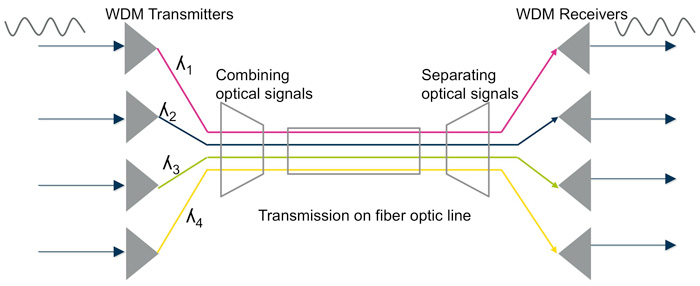Unraveling the Mysteries of FDM, TDM, and WDM
What Are Multiplexing Technologies?
In optical fiber communication, multiplexing is considered the primary means for expanding existing fiber network infrastructure. It allows multiple independent signals to be transmitted over the same communication channel, thereby improving channel utilization. In multiplexing, multiple signals share the same transmission medium, effectively utilizing different parameters or dimensions to enable these signals to be transmitted in the same time or space without interfering with each other.
The most commonly used multiplexing technologies include Frequency Division Multiplexing (FDM), Time Division Multiplexing (TDM) and Wavelength Division Multiplexing (WDM). The following will focus on the in-depth introduction of these technologies.
Frequency Division Multiplexing
Frequency division multiplexing, often abbreviated as FDM, is a predominant analog technique widely utilized in TV and radio transmission. It consolidates multiple signals into a singular transmission, facilitating their transmission over a shared communication channel. FDM entails segmenting the channel bandwidth into discrete logical sub-channels, with each sub-channel designated for a specific signal frequency. To ensure seamless integration, individual signals undergo filtration and modulation, wherein their frequencies are adjusted to align precisely with the allocated logical sub-channels.
Under this approach, each user is allocated a distinct logical sub-channel corresponding to their specific signal frequency, effectively granting ownership of a dedicated sub-channel to each user. To prevent signal interference and overlap, adjacent logical sub-channels are separated by a vacant bandwidth known as a Guard Band. Essentially, a guard band serves as a narrow frequency range that acts as a barrier, preventing the overlap of neighboring signal frequencies.

Figure1. FDM Working Principle
Time Division Multiplexing
TDM is a technique that divides different signals into time slots and then transmits them in the order of these slots. In optical communication, Optical Time-Division Multiplexing (OTDM) is a variant of TDM that utilizes the time resolution of optical pulses for time-division multiplexing of optical signals.
Specifically, OTDM multiplexes several low-bit-rate optical channels into a fixed electrical clock period, thereby increasing the transmission speed. Each signal is transmitted by dividing the time frame into time slots, with each slot dedicated to a message signal. Based on time, each low-speed channel is allocated to a specific position, operating in synchronized mode. Therefore, OTDM achieves multiplexing of multiple signals by temporally segmenting and interleaving different optical channels.
Usually, the optical pulse width is shortened in order to multiplex more channels within the fixed clock period. In addition, the shortened pulse width can reduce the crosstalk between channels because of more room left in bit rate. However, short pulse width results in heavy dispersion as traveling distance increases. Therefore, transform-limited pulse and dispersion slope compensation technique need to be used to reduce the dispersion effect on OTDM.

Figure2. TDM Working Principle
Wavelength Division Multiplexing
WDM is one of the optical multiplexing techniques that increases bandwidth by multiplexing a variety of optical carrier signals onto a single optical fiber by using different wavelengths. Each signal at WDM wavelengths is independent of any protocol and any speed. WDM technology allows bidirectional communications simultaneously over a single optical fiber. The foundation of WDM simplifies the network to a single virtual optical fiber network instead of using multiple forms of signals with different fibers and services. In this way, WDM increases the bandwidth and lowers the networking cost by reducing the needed fibers.
There are two different wavelength patterns of WDM system, coarse wave division multiplexing (CWDM) and dense wavelength division multiplexing (DWDM). CWDM and DWDM are based on the same concept of using multiple light wavelengths on a single fiber, but differ in the spacing of the wavelengths, numbers of channels, and the ability to amplify the multiplexed signals in the optical space. In a WDM system, different optical signals are combined (multiplexed) together at one end of the optical fiber and separated (demultiplexed) into different channels at the other end. If you want to know more, check out WDM Basics: Understanding Wavelength Division Multiplexing Technology .

Figure3. WDM Working Principle
What Are the Differences Between FDM, TDM and WDM?
Functionality
FDM splits the bandwidth into smaller frequency ranges, allowing multiple data transmissions to occur simultaneously through a shared channel, with each transmission confined to its specific frequency range. TDM assigns a designated time slot to each user, enabling them to transmit signals through a shared channel. During their allocated time slot, the user has access to the entire bandwidth. WDM merges multiple light beams from various channels into a single light beam, transmitting it through a fiber optic strand in a manner similar to FDM.
Type of Signals
FDM employs analog signals. TDM utilizes both digital and analog signals. WDM uses optical signals.
Conclusion
In summary, this article has introduced three commonly used multiplexing technologies in the field of optical communication – FDM, TDM and WDM.These technologies play a crucial role in shaping the landscape of efficient data transmission.
Among all the multiplexing technologies, WDM finds the most extensive application in optical communication. As different multiplexing techniques have their limitations in some aspects, it is usually suggested to use more than one technique in fiber optic networks to get the best transmission performance. FS offers an extensive range of top-notch WDM equipment products, including Mux/Demux, OADM, Transponders/Muxponders, and an array of module products for OTN tailored to meet a diverse spectrum of requirements. These module products cover a wide range of speeds, from 1G to 400G, ensuring that we cater to your specific needs and provide solutions that are both versatile and high-performing.
You might be interested in
Email Address

-
PoE vs PoE+ vs PoE++ Switch: How to Choose?
May 30, 2024













